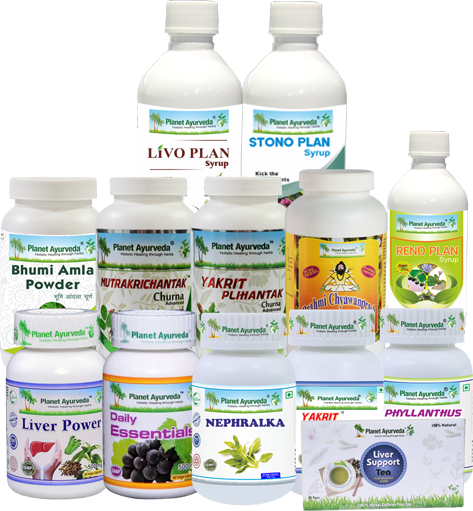Bhumi Amla: Benefits, Uses, Formulations, Dosage And Side Effects
Abstract
Bhumi Amla (Phyllanthus Niruri) is a widespread tropical plant known as Stone Breaker or Gale of the Wind. Bhumi Amla is an herb available in different forms such as Tablets, Capsules or powders which is helpful in various conditions without causing any side effects. This herb is useful in various Liver problems as the Liver is an amazing organ which performs various functions in the human body. The liver is a crucial internal organ that helps with energy storage, medication and chemical metabolism, nutrition digestion, and food breakdown. Its healthy operation is vital to general health. The potent herb, Bhumi Amla, used for thousands of years in Ayurveda, the age-old ancient medical system that started in India, is an excellent remedy for all liver ailments. Bhumi Amla is well documented in various ancient Ayurvedic texts which provide health benefits to all groups. In this article, we are going to discuss its Morphology, its geographical Distribution and the therapeutic uses which are helpful without causing any side effects.

Introduction
Phyllanthus Niruri is commonly known as Gale of Wind which is a tropical herb that grows at a height of 70 cm and is extensively seen in the Coastal areas and is commonly known as Dukong Anak and Bhumi Amalaki in the Sanskrit language. Bhumi Amla is used as a key ingredient in many formulations which is helpful in boosting immunity and has various therapeutic properties in its leaves, roots and other parts of the plant. Bhumi Amla is Useful in treating various conditions such as Fever, Inflammation of the liver and various skin conditions.
Synonyms
- Shatamala, Bahupatra – Bhumi Amla has many leaves.
- Bahusuta, Bahuphala – Bhumi Amla has many fruits
- Tamalaki – Resembles Amalaki
- Amala – Purifies the body
- Shiva and Shubhaukini – Is Auspicious
- Bhoomi Amalaki, Bhu-Dhatri – The small fruits grow on the ground level
Botanical Distribution Of Bhumi Amla (Phyllanthus Niruri)
Bhumi Amla (Phyllanthus Niruri) is a small herbaceous plant which grows at the height of 30-60 cm in height.
- Leaves – The leaves of Bhumi Amla are elliptically shaped and have no stalk directly growing from the stem.
- Arrangement – There are alternate types of arrangement with 2 short petioles and stipules.
- Fruits – The fruit of Bhumi amla is small, oval-shaped, and contains various seeds.
- Flower – Flowers are pale green in colour and are often seen in red colour, and are found in pairs.
- Stem – Is cylindrical, Smooth and Glabrous.
- Branches – Is angular
- Bark – Is smooth and light green in colour.
- Roots – The roots of Bhumi Amla are small, 2.5 cm long, and have several fibrous secondary and tertiary roots. The colour of the roots is light brown in colour.
Production Technology
- Climate-
- Temperature – 28-38 degrees
- Rainfall – 25 cm
- Sowing Temperature – 30 degree
- Harvesting Temperature – 23-20 degrees
- Soil – Bhumi Amla is growing in a wide range from alkaline to neutral acidic.
- Land Preparation – Bhumi Amla is prepared in the month of April-May.
- Sowing-
- Time of Sowing – In the months of March – April
- Spacing – 15 cm x 10 cm
- Method of Sowing – Transplanting at a height of 10-15 cm
- Harvesting – It is done in the month of September after the rainy season.
Geographical Distribution
Bhumi Amla is usually found in India and in temperate regions, in Assam, Bihar and in Southern India.
Vernacular Names
- Common name – Phyllanthus, Stonebreaker, gale of wind
- Sanskrit name – Bahupatra, Tamalaki
- Hindi name – Bhumi amla, Jangli amlai
- Marathi – Bhui avla, Bhui amla
- Kannada – Bhu nelli, Nelanelli
- Tamil – Kilanelli
- Telugu – Nela usiraka
- Urdu – Bhumi Amla
- Spanish – Chanca piedra
- Malayalam Name – Kizhukanelli and Kizharnelli
- Bihar – Meri Koa and Kandara
- Sindhi Name – Niruri
- Bengali Name – Bhui Amla
Watch Video on Phyllanthus Herb by Dr. Vikram Chauhan (MD Ayurveda)
Phytochemical Constituents Of Bhumi Amla
Bhumi Amla contains various phytochemicals which are plant-based and provide many useful medicinal properties. It comprises- Phyllenthin, Lignans, Flavonoids, Glycosides, Alkaloids, Phenylpropanoids, Amarin, Corilagin and it contains Kaempferol, Niranthin which is mainly derived from the leaves of Bhumi Amla.
Ayurvedic Properties
- Rasa (Taste) – Tikta (Bitter), Kashaya (Astringent), Madhura (Sweet)
- Guna (Qualities) – Laghu (Light for digestion), Ruksha (Dry in nature)
- Veerya (Potency) – Sheeta (Cold)
- Vipaka (After digestion taste conversion) – Madhura (Undergoes sweet taste after digestion)
- Karma (Actions) – Kapha Pitta Shamak (Reduces Kapha & Pitta dosha), Laxative, Nootropic.
Uses Of Bhumi Amla As Per Ayurveda
- Rochani – In Anorexia
- Pandu – Anaemia
- Raktapitta – Bleeding disorder such as Epistaxis, Menorrhagia
- Kaphaja Kushtha – Skin diseases
- Vishakha – Toxin conditions
- Hidhma – Hiccups
- Trishna – Excessive thirst
- Pipasa – Dry Mouth
- Pitta Meha – Diabetes and urinary tract disorders
- Anulomana – It is helpful in breathing
- Sangrahani – Treats Diarrhea
Actions Of Bhumi Amla
- Astringent
- Appetiser
- Carminative
- Laxative
- Has Biliary and urinary cell protective property
- Analgesic
- Anti-hepatotoxic property
Benefits And Therapeutic Uses Of Bhumi Amla
- In Liver Disorders – Bhumi Amla has Hepatoprotective property which is helpful in enhancing the functions of the liver and it contains Phyllanthin which reduces the liver marker enzymes and the levels of collagen. Phyllanthin combats the CCl4-induced fibrosis and Hepatotoxicity. It has a Pitta balancing property which manages the pitta doshas in the body.
- In Respiratory Health – Bhumi Amla is effectively useful in respiratory troubles, Bhumi Amla contains Kaempferol which is a flavonol useful in treating various Allergic Respiratory disorders including Acute injury of the Lungs and ischemia. Has Anti-inflammatory and Anti-oxidative properties. Eases breathing and is useful in getting rid of mucus from the respiratory tract.
- In Kidney Functions – Bhumi Amla has diuretic properties which flush out the toxins and urine from the body. Bhumi Amla contains Flavonoids which have various benefits on the health of the kidney including – Preventing renal injury and thus improving the structure of the kidney. Bhumi Amla decreases blood pressure by directly acting on the parenchyma of the kidney.
- Treats Ulcers and Wounds – Bhumi Amla has Anti-inflammatory and pain-relieving properties which treat Ulcers. Corilagin a constituent which is present in Bhumi Amla treats the scars and heals the wounds, as it reduces the migratory ability. Improves cellular inflammation and promotes tissue regeneration.
- Stress – Bhumi Amla has soothing properties which eliminate episodes of Anxiety such as Uneasiness and cold hands and feet, this plant has a calming effect to make people more positive and feel better.
- Weight Loss – Bhumi Amla has Flavonoids which are helpful in shedding excessive weight faster. Flavonoids regulate the metabolism of Lipids and improve the process of digestion which is useful in Weight Loss.
- Skin Problems – Bhumi Amla has various antioxidants and antimicrobial properties which treat various disorders of the skin such as Acne, Warts and Itching. Topically applying the paste of Bhumi Amla improves the complexion of the skin and facilitates healing.
Parts Used
- Stems
- Leaves
- Fruits
- Flowers
- Roots
Dosage Of Bhumi Amla
- In Powder Form – 3-6 grams
- In Swaras Form – 20-30 ml Twice daily
Side Effects
When Bhumi Amla is taken under appropriate doses it will not cause any side effects. Bhumi Amla is effective in normalizing the aggravated doshas of the body. Very high doses of Bhumi Amla cause the elimination of fluid from the body. So diabetes patients must take care before using Bhumi Amla.
Pregnant and Lactating mothers must take care before using any product as it must be under the strict supervision of Ayurvedic Expertise.
Planet Ayurveda’s Products Which Have Bhumi Amla As An Ingredient
- Bhumi Amla Powder
- Phyllanthus Niruri
- Yakrit Plihantak Churna
- Livo Plan Syrup
- Mutrakrichantak Churna
- Nephralka Capsules
- Reno Plan Syrup
- Stono Plan Syrup
- Yakrit Plihantak Capsules
- Liver Power
- Liv Support Tea
- Daily Essentials
- Brahmi Chawanprash
Home Remedies From Bhumi Amla
- In Food Allergies – The Swaras of Bhumi Amla are given to children below 7 early to treat food intolerance and in food allergies
- In Fever – The decoction of Bhumi Amla leaves is useful in fever
- In Eye Allergies – The paste prepared from the freshly crushed leaves is applied over the Eyelids which treats Conjunctivitis and Blepharitis.
- Skin Purifier – Bhumi Amla is used as a blood purifier which treats various skin Diseases.
- Diabetes and Chest Pain – The decoction of Bhumi Amla is helpful for Diabetes.
- Whole plant juice of Bhumi Amla is used to treat gonorrhea, menorrhoea, leucorrhea, and other urinary tract issues.
Conclusion
Bhumi Amla, a powerful herb, has been used for thousands of years in Ayurveda, an ancient Indian medical system, and is a great treatment for all liver conditions. Numerous traditional Ayurvedic books extensively record the health advantages of Bhumi Amla, which are beneficial to all populations. Bhumi Amla is helpful in the treatment of a number of ailments, including fever, hepatic inflammation, and a number of skin disorders. Then we discussed various uses and benefits of Bhumi Amla which provides good results without causing any side effects.
FAQs on Bhumi Amla
1. Why does Bhumi Amla have the name Bahupatra?
The name Bahupatra comes from the way the leaves are shaped. This plant has a large number of small leaves. Many round fruits with an Amala fruit-like look can be found beneath its leaves. These fruits have seeds inside of them. These fruits open and release seeds that germinate and spread throughout the land (Bhumi), creating new plants.
2. What Constitutes Bhumi Amla Contains?
The stem, roots, and leaves of Bhumi Amla are home to bioactive lignans, glycosides, alkaloids, flavonoids, phenylpropanoids, ellagitannins, gernanin, amarin, and corilagin. Niranthin and nirtetralin phyltetralin are found in leaves. Roots contain lup 20 (29) – en – 3 beta – ol, eriodictyol – 7 rhamnopyranoside, and kaempferol – 4 rhamnopyranoside.
3. Why is Stonebreaker the name given to Bhumi Amla?
This herb’s chemical and therapeutic qualities have earned it the name “stonebreaker.” It breaks down kidney and gallbladder stones of all kinds naturally and without any negative side effects.
4. Which kinds of liver disorders does Bhumi Amla help with?
The herb helps with five main viral hepatitis types in addition to liver inflammation. It works well for liver cirrhosis, liver failure, hepatomegaly, jaundice, and a number of other liver problems.
5. Does Bhumi Amla give Results for Splenomegaly?
Indeed, the herb is effective not only for hepatomegaly but also for splenomegaly. This herb’s various qualities all support the preservation of a healthy spleen.
6. Is Bhumi Amla contraindicated after longer use?
This herb has no negative effects, but if taken in excessive amounts, it can raise the body’s vata dosha. Dysentery and diarrhea might occasionally result from taking a greater dose of it.




